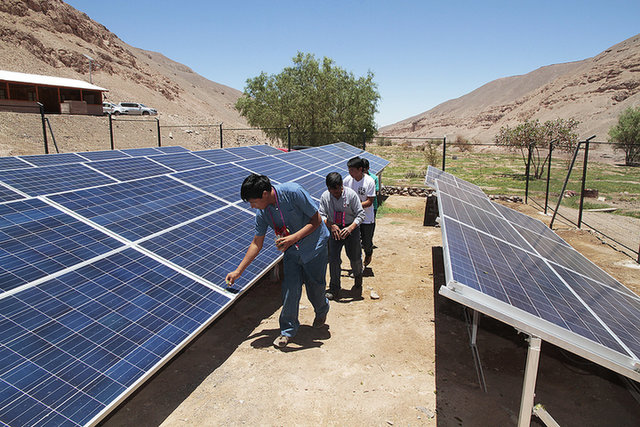HSE
No compromise: Anglo American’s 2018 sustainability performance
In its 2018 results, Anglo American reported improvements in production and profitability and its 2018 Sustainability Report demonstrates that it has achieved its goals without compromising safety and environmental performance. JP Casey looks at how the company has managed to balance production and compliance, and where it goes from here.


Image courtesy of Anglo American
2018 was a strong year for Anglo American. The world’s largest diamond miner saw increases in thge production of copper, diamonds, platinum and palladium compared to 2017, with copper in particular seeing a 15% increase in production to 668,000 tonnes. Anglo American’s revenue increased by 5% and earnings before interest, taxes, depreciation and amortisation jumped by 4%.
Critically, the company has posted these impressive results without compromising on safety and environmental performance. CEO Mark Cutifani said when announcing the 2018 results that “no degree of financial performance is worth a life”, and while this is a common refrain in the mining industry, Anglo American has taken steps to ensure this isn’t empty rhetoric.
Initiatives such as the FutureSmart Mining programme, which encourages technological innovation in the company, have given Anglo American a number of opportunities to deliver strong safety and environmental performance, and the programmes have been effective.
The company’s 2018 Sustainability Report notes reductions in work-related fatalities, lost-time injuries, greenhouse gas emissions and energy consumption between 2017 and 2018, alongside dramatic improvements in managing specific conditions, such as tuberculosis. While there is still work to be done in relation to specific dangers, such as occupational diseases and HIV/AIDS, the company is optimistic that it can achieve both its short and long-term goals in environmental and safety performance.
More than half of the country’s coal mines are managed by pro-Russian separatist militia.
Credit: DmyTo/Shutterstock.
Reaching and exceeding the Sustainable Development Goals
Anglo American’s sustainability work is guided by its sustainable mining plan, a long-term project developed in line with the UN Sustainable Development Goals (SDGs), a list of 17 targets to guide global development until 2030. Anglo American has integrated its own sustainability targets into the framework of the SDGs, ensuring that every advancement made in relation to mining can be applied to development beyond the industry.
“Our sustainable mining plan is the result of rigorous and far-reaching consultation,” said the company. “Assessing our activities against the SDGs, we identified the areas where we either have material impact or where we can make a material difference. We are focusing our efforts on three pillars: trusted corporate leader, thriving communities and healthy environment.”
The latter pillar involves ensuring water quality, protecting biodiversity and limiting climate change. These targets fit very closely with UN SDGs relating to ensuring water quality, providing sustainable infrastructure, working to protect the environment and safeguarding animal and plant life, so the goals are very closely aligned.
“Anglo American aims to reduce greenhouse gas emissions by 22% by 2020 compared to the business-as-usual (BAU) projections, but it has already hit reductions of 25% compared to BAU figures in 2018.”
All of these influences have resulted in targets that are highly ambitious, but not beyond reach. The company aims to reduce greenhouse gas emissions by 22% by 2020 compared to the business-as-usual (BAU) projections, but it has already hit reductions of 25% compared to BAU figures in 2018. Anglo American aims to reduce energy consumption by 8% compared to BAU figures by 2020, and had already achieved a 6.5% reduction in 2018.
“By 2020, each of our operating managed sites will be required to have a five-year plan towards meeting our sustainability stretch goals and other objectives,” said Anglo American. “During the year ahead, we will establish the necessary framework and baseline data to be able to track progress and correct course as needed.”
The company is looking to reduce greenhouse gas emissions by 30%, improve energy efficiency by 30%, and reduce the abstraction of freshwater in water-scarce regions by 50% in the next eleven years. 2030 will see the end of the SDGs, and another round of targets for Anglo American.
More than half of the country’s coal mines are managed by pro-Russian separatist militia. Credit: DmyTo/Shutterstock.
Work still to be done
While the company’s performance has been largely impressive, some areas for improvement remain. In 2018 one single significant environmental incident occurred for the company, when two pipelines leaked at its Minas-Rio project in Brazil. This required extensive repair work and led to the suspension of work that cut the project’s iron ore production by 80% compared to 2017 figures. However, Anglo American was able to respond to the incident quickly, with the company’s commitment to environmental risk assessment proving effective.
“In response to the pipeline-spill incidents, we took swift and effective action to assess the integrity of the entire pipeline, as well as reviewing the maintenance strategy, the controls in place and the use of technology to predict pipeline failures,” said Anglo American, discussing how its long-term commitment to completing environmental risk assessment helped it minimise these impacts.
“Moreover, the integration of environmental risk management into our operational risk management process is enabling improved reporting and learning from these high-potential incidents and high-potential hazards.”
“Anglo American miners are among the most likely to contract HIV, a fact demonstrated by an increase in the number of new cases of HIV among company employees, rising from 506 in 2017 to 540 in 2018.”
The company has also struggled to minimise exposure to diseases, with the number of diseases related to “health hazard exposure” jumping from 23 in 2017 to 61 in 2018, a five-year high that brought to an end four consecutive years of reductions in occupational diseases.
While projects to tackle some of the more significant occupational diseases have been effective, with a 2016 expansion of a tuberculosis drug used to treat platinum miners contributing to a fall in new cases of tuberculosis from 669 to 242 from 2016 to 2018, others have been less successful.
HIV/AIDS is common in South Africa, as is tuberculosis, with charity Avert reporting that the rate of co-infection of the two diseases is around 60% in the country. As a result, Anglo American miners are among the most likely to contract HIV, a fact demonstrated by an increase in the number of new cases of HIV among company employees, rising from 506 in 2017 to 540 in 2018.
However, the number of AIDS-related deaths fell over this period from 12 to 3, and there have been increases in both the number of employees who have been tested for the conditions, and the proportion of HIV-positive employees receiving treatment, so the company is optimistic new cases will fall in the coming years.

Image courtesy of Anglo American
Specialised projects and sophisticated technology
“This was a foundation year for sustainability as a whole, not just environmental performance,” said an Anglo American spokesperson when describing the new initiatives introduced to improve the company’s performance. “We are also connecting technology and digitalisation to our sustainable mining plan, to create a more sustainable business in every sense."
This project, dubbed ‘FutureSmart Mining’, is one such initiative that has had a significant influence on the company’s environmental performance, with technologies such as hydrogen fuel cells reducing the reliance on fossil fuels and traditional energy sources. Anglo American has worked to reduce its dependence on fossil fuels, cutting its usage of energy from fossil fuels from 61.1m gigajoules (GJ) in 2014 to 45.6mGJ in 2018, a shift that has driven a reduction in carbon dioxide emissions from 17.3 million tonnes (Mt) to 16Mt over the same period.
The approach has encouraged collaboration with other large companies across industries. Anglo American has partnered with Hyundai to develop a hydrogen-powered car as part of the London Hydrogen Network Expansion, a £50m project to establish hydrogen refuelling infrastructure in the UK capital.
“Many of the technologies we are developing and now implementing at scale in our operations serve to significantly reduce our energy and water usage per tonne of metal or mineral,” said the company. ”Alongside the obvious benefits of a smaller environmental footprint, the cost and throughput improvements have the potential to change the future of mining. In our world, sustainable mining is just good business.”
“The rise of automation has two clear advantages with regard to safety and environmental performance.”
Many of these features have been trialled at the company’s Twickenham platinum mine in South Africa, which includes a number of smart technologies, from a continuous haulage system developed by Sandvik to a more efficient slot borer designed by Atlas Copco.
The rise of automation has two clear advantages with regard to safety and environmental performance: by optimising processes such as the routes a vehicle drives or the holes a piece of machinery drills, power consumption and harmful emissions are minimised; and by removing human workers from potentially hazardous areas such as underground mines or the cabs of vehicles, the mines will expect to see fewer injuries.
This approach has resulted in a significant reduction not only in the number of workers injured at Anglo American operations, but a reduction in the number of workers exposed to hazardous situations. The report notes that the number of employees potentially exposed to hazards fell from 124,726 to 102,606 from 2017 to 2018, and with the number of first aid cases remaining relatively constant over the period, rising marginally from 1,500 to 1,562, prevention may remain the best remedy.

More than half of the country’s coal mines are managed by pro-Russian separatist militia. Credit: DmyTo/Shutterstock.
